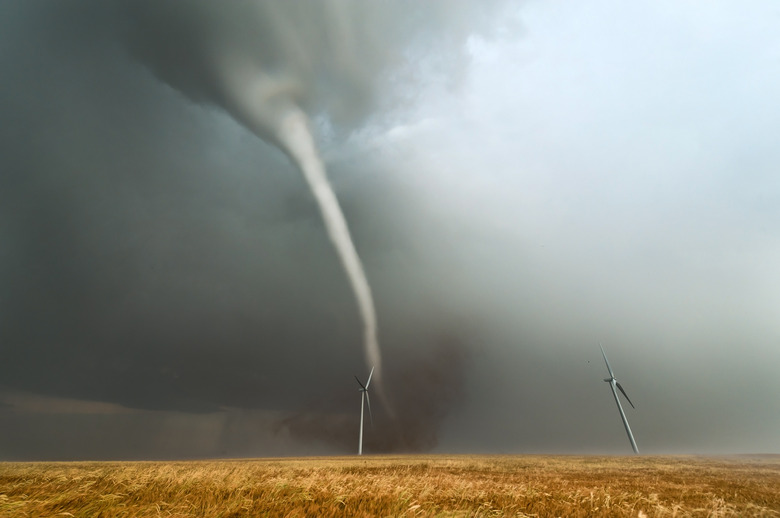The Causes & Effects Of Tornadoes
Tornadoes occur where unstable air creates wind funnels that destroy homes and uproot trees. This happens when updrafts of warm and wet air collide with cold air. Tornadoes primarily develop across the Great Plains in the United States in an area referred to as tornado alley. Tornado alley covers land in the lowland areas of the Mississippi River, the lower Missouri River valleys and Ohio. The states affected include Texas, Oklahoma, Nebraska, Missouri, Mississippi, Alabama, Arkansas, Iowa, Kansas and Florida.
TL;DR (Too Long; Didn't Read)
When cold air meets warm and wet air, the surrounding air currents become unstable, air pressure drops and the conditions for tornado creation are ripe. The effects of these devastating storms include:
* People killed or seriously injured
* Mobile homes completely flattened
* Homes ripped from their foundations
* Livestock lost or destroyed
* Cars tumbled and damaged
* Landscaping destroyed
The largest tornado touched down in May of 2013 near Moore, Oklahoma resulting in a path of destruction that spanned 2.6 miles across and 16.2 miles long. Though it had winds in excess of 295 mph, the tornado itself was an EF-3 tornado on the enhanced Fujita scale, a measurement that determines the strength of a tornado's winds.
How Tornadoes Form
How Tornadoes Form
Tornadoes develop in weather conditions where three different layers of air combine in a specific way. The three air layers consist of a layer of warm and humid air with strong south winds near the ground, cold air in the upper atmosphere pushed around by strong west and southwest winds and a very warm, dry layer of air sandwiched between these upper and lower air levels.
The middle layer provides a cover which allows the ground atmosphere to warm some more, making all the air in the system unstable. When a storm cell above moves east, it lifts the multiple layers, removing the cap in the middle layer that results in strong updrafts. The exchange between the updrafts and surrounding storm winds can cause the rotating effect that generates the wind funnel known as a tornado.
When Tornadoes Form
When Tornadoes Form
Tornado season requires the right conditions. This includes a layer of moist warm air near the ground, which primarily occurs during spring and summer thunderstorms. For the southern states, this season runs from March through May, but in the northern climes, tornadoes occur in the summertime. Somewhere between 800 and 1,000 tornadoes touch down in an average tornado season across the U.S., resulting in about $850 million in property damages each season.
Enhanced Fujita Scale and Damage Extent
Enhanced Fujita Scale and Damage Extent
Tornadoes get their ratings from the strength of their winds, which can also determine the damages they cause. The Fujita scale gets its name from the scientist who introduced it in 1971, Tetsuya Fujita. In 2007, an updated version called the Enhanced Fujita scale that rates wind strength differently replaced the original Fujita scale. In the new version:
EF-0: 65 to 85 mph winds result in some damage to house gutters, siding and roofs. You may also see broken tree branches and small trees get pushed over.
EF-1: 86 to 110 mph winds cause damage to mobile homes including complete rollovers. Winds can strip roofs, and exterior doors to homes on foundations are often removed with windows broken.
EF-2: 111 to 135 mph winds remove roofs from well-built homes. Stick-built houses shift, mobile homes get flattened, large trees get broken and removed from the ground, and the winds can lift cars off the ground.
EF-3: 136 to 165 mph winds result in damage to multiple stories of well-built homes. Office buildings and malls experience severe damage, trains overturn, and trees lose bark. Winds throw heavy vehicles through the air, and any structure with a weak foundation is at risk of destruction.
EF-4: 166 to 200 mph winds can destroy well-constructed and stick-built homes, throw cars into the air and make debris fly everywhere.
EF-5: 200 mph winds and above devastate everything in the path of the tornado. High-rise buildings experience severe damage, and car-sized debris flies through the air.
Cite This Article
MLA
Brenner, Laurie. "The Causes & Effects Of Tornadoes" sciencing.com, https://www.sciencing.com/causes-effects-tornadoes-8204458/. 11 April 2018.
APA
Brenner, Laurie. (2018, April 11). The Causes & Effects Of Tornadoes. sciencing.com. Retrieved from https://www.sciencing.com/causes-effects-tornadoes-8204458/
Chicago
Brenner, Laurie. The Causes & Effects Of Tornadoes last modified March 24, 2022. https://www.sciencing.com/causes-effects-tornadoes-8204458/
